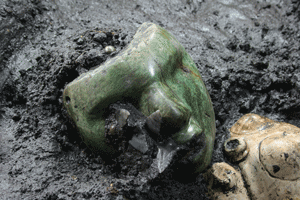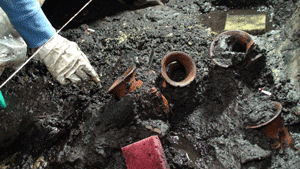

(Courtesy INAH)
Archaeologists working in a
tunnel beneath Teotihuacan's
Pyramid of the Sun
have unearthed two caches of artifacts
that may have been meant to
consecrate the massive building's
construction around a.d. 200. The
ancient city, which lies about 40
miles north of Mexico City, was
once a major spiritual center with
the Pyramid of the Sun as its largest
monument. The research team, led by Alejandro Sarabia of
Mexico's National Institute of Anthropology and History,
expanded a tunnel that was originally excavated in the 1930s
and dug additional tunnels out to the sides. The tunnels
revealed a small artifact cache near the center of the pyramid
and another larger cache about 125 feet away. The excavations
also uncovered four sacrificial burials,
three of them holding children,
in different locations.
The cache at the center of the
pyramid contained a pyrite and slate disk with a human
figure made of obsidian placed on top of it. Projectile points
as well as seashells and a few stone blades surrounded the
figure. The larger cache comprised 11 clay pots dedicated
to a rain god, obsidian and stone blades, projectile points,
the bones of an eagle, and fragments of feline and canine
skeletons. Among the most intriguing
artifacts were three carved greenstone
figurines that depict human beings
and a greenstone mask similar to those
found in the tombs of some especially
wealthy Maya rulers. It was the first
such mask to be found in a ritual setting
at the site and does not appear to
have been part of a grave.
The excavations also revealed that
other buildings had stood on the site
before the pyramid was built. The
team happened upon the walls of
three different buildings and another
wall that may have surrounded a plaza
or ceremonial space, providing some
information about the early phases of
construction at the site. Saburo Sugiyama
of Arizona State University and
Aichi Prefectural University in Japan,
the archaeologist who directed the
excavations, expects even more intriguing
finds will be discovered beneath the
pyramid. "There is a good chance of
finding the tomb of a ruler in the next
year or two," he says.

